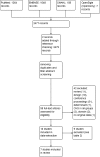Chlorhexidine body washing to control antimicrobial-resistant bacteria in intensive care units: a systematic review
- PMID: 22527065
- PMCID: PMC3351589
- DOI: 10.1007/s00134-012-2542-z
Chlorhexidine body washing to control antimicrobial-resistant bacteria in intensive care units: a systematic review
Abstract
Purpose: Infections caused by antimicrobial-resistant bacteria (AMRB) are increasing worldwide, especially in intensive care units (ICUs). Chlorhexidine body washing (CHG-BW) has been proposed as a measure to limit the spread of AMRB. We have systematically assessed the evidence on the effectiveness of CHG-BW in reducing colonization and infection with AMRB in adult ICU patients.
Methods: PubMed, Embase, CINAHL, and OpenSigle databases were searched using synonyms for "intensive care unit," "hospital," and "chlorhexidine." All potentially relevant articles were examined by two independent reviewers. Inclusion was limited to studies with ICU patients as domain, providing outcomes related to colonization or infection with AMRB. Data from 16 studies were extracted; 9 were excluded because of assessed high risk of bias or inadequate analyses. The remaining studies differed markedly in (co-)interventions and case mix, which precluded pooling of data in a formal meta-analysis.
Results: Incidences of MRSA acquisition were reduced significantly in three studies in which this was the primary endpoint. Significant reduction in MRSA infection rates was observed in only one of five studies. Carriage and bacteremia rates of VRE were assessed in one study, and both significantly declined. There were hardly any data on the effects of CHG-BW on antibiotic-resistant gram-negative bacteria (ARGNB).
Conclusions: CHG-BW may be effective in preventing carriage, and possibly bloodstream infections, with MRSA and VRE in different ICU settings. As CHG-BW protocols, co-interventions and case mix varied widely, attribution of these effects to CHG-BW alone should be done with care. Evidence that CHG-BW reduces carriage of or infections with ARGNB is lacking.
References
-
- ECDC (2008) EARSS Annual Report. http://wwwecdceuropaeu/en/activities/surveillance/EARS-Net/Documents/200...
-
- Goldmann DA, Weinstein RA, Wenzel RP, Tablan OC, Duma RJ, Gaynes RP, Schlosser J, Martone WJ. Strategies to prevent and control the emergence and spread of antimicrobial-resistant microorganisms in hospitals. a challenge to hospital leadership. JAMA. 1996;275:234–240. doi: 10.1001/jama.1996.03530270074035. - DOI - PubMed
-
- WHO (2009) Guidelines on hand hygiene in health care. http://whqlibdocwhoint/publications/2009/9789241597906_engpdf - PubMed
Publication types
MeSH terms
Substances
LinkOut - more resources
Full Text Sources
Medical
Research Materials


